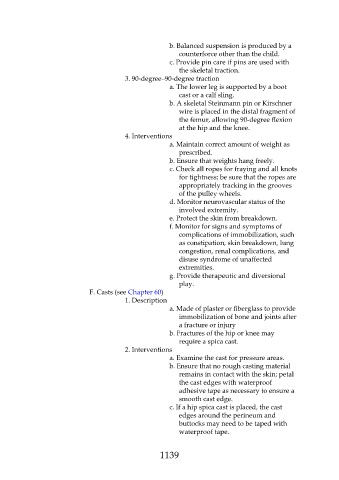Page 1139 - Saunders Comprehensive Review For NCLEX-RN
P. 1139
b. Balanced suspension is produced by a
counterforce other than the child.
c. Provide pin care if pins are used with
the skeletal traction.
3. 90-degree–90-degree traction
a. The lower leg is supported by a boot
cast or a calf sling.
b. A skeletal Steinmann pin or Kirschner
wire is placed in the distal fragment of
the femur, allowing 90-degree flexion
at the hip and the knee.
4. Interventions
a. Maintain correct amount of weight as
prescribed.
b. Ensure that weights hang freely.
c. Check all ropes for fraying and all knots
for tightness; be sure that the ropes are
appropriately tracking in the grooves
of the pulley wheels.
d. Monitor neurovascular status of the
involved extremity.
e. Protect the skin from breakdown.
f. Monitor for signs and symptoms of
complications of immobilization, such
as constipation, skin breakdown, lung
congestion, renal complications, and
disuse syndrome of unaffected
extremities.
g. Provide therapeutic and diversional
play.
F. Casts (see Chapter 60)
1. Description
a. Made of plaster or fiberglass to provide
immobilization of bone and joints after
a fracture or injury
b. Fractures of the hip or knee may
require a spica cast.
2. Interventions
a. Examine the cast for pressure areas.
b. Ensure that no rough casting material
remains in contact with the skin; petal
the cast edges with waterproof
adhesive tape as necessary to ensure a
smooth cast edge.
c. If a hip spica cast is placed, the cast
edges around the perineum and
buttocks may need to be taped with
waterproof tape.
1139

